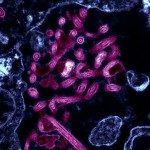Lien vers Pubmed [PMID] – 16419106
J. Med. Virol. 2006 Mar;78(3):329-34
Using DNA chip technology and real-time quantitative PCR, molecular profile of HBV strains infecting blood donors and patients in Dakar, Sénégal was studied. All HBsAg-positive blood donors (n = 175) and all patients who presented with chronic hepatitis B (n = 29) between 1st June 2003 and 31st July 2003 were studied. One patient, a blood donor, was coinfected by HCV, and nine patients had anti-HDV antibodies. Few persons in either group were HBeAg-positive. Viral load values were relatively low but correlated with biochemical abnormalities. Patients were infected mainly by genotype E (72%). Patients infected by genotype A (28%) tended to be younger than other patients. There was no significant difference between the blood donors and the patients with hepatitis B as regards virological markers, including viral load, when the HBV genotype was taken into account. The BCP A1762T and G1764A mutations were found in four patients and one patient, respectively; the two mutations were never found in the same patient. The W28* mutation at position 1896 of the core was detected in 19 of the 32 genotyped patients, 18 (83%) of whom had genotype E infection. ALT levels were not influenced by HBV mutations. This study shows a low frequency of clinical signs in HBsAg-positive blood donors, a relatively low level of viral replication, and a high frequency of pre-core mutants in this West African population. These results underline the importance of molecular characterization of HBV infection as specific treatments become available in this region.

